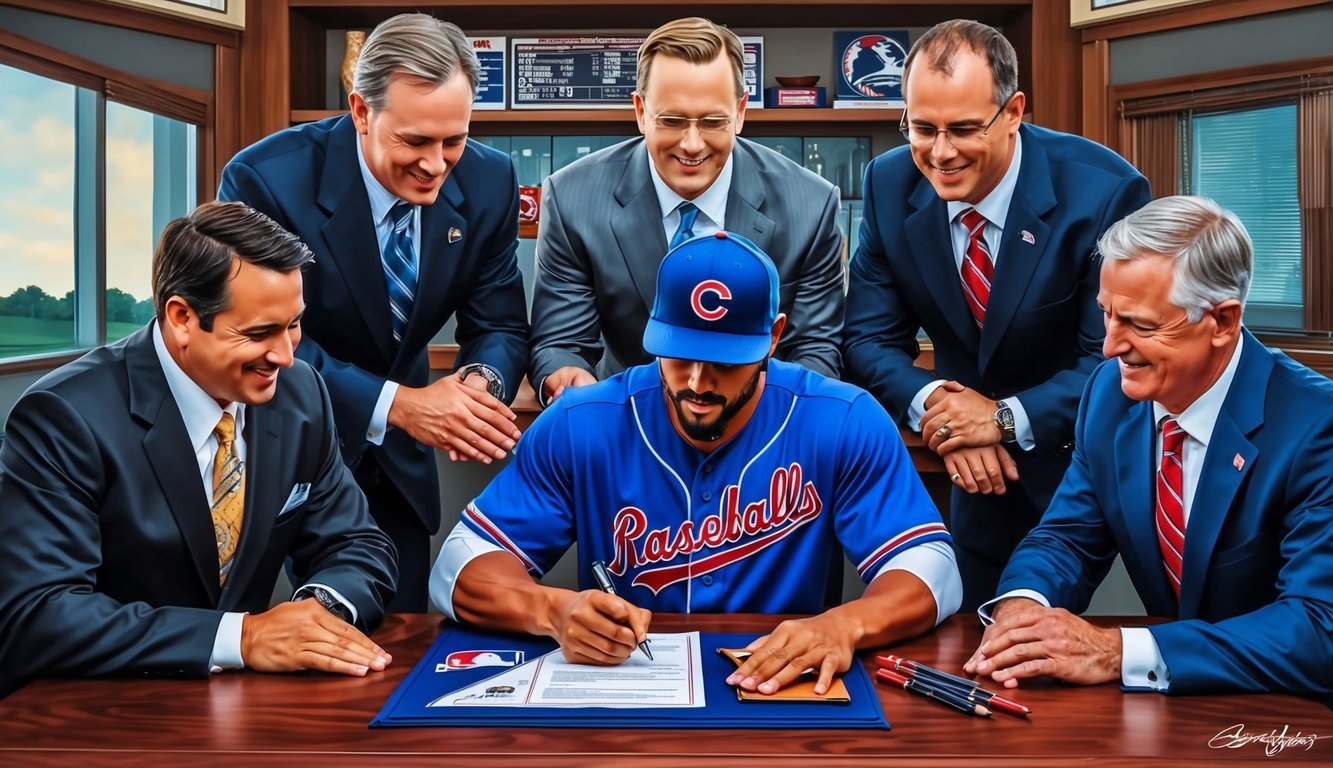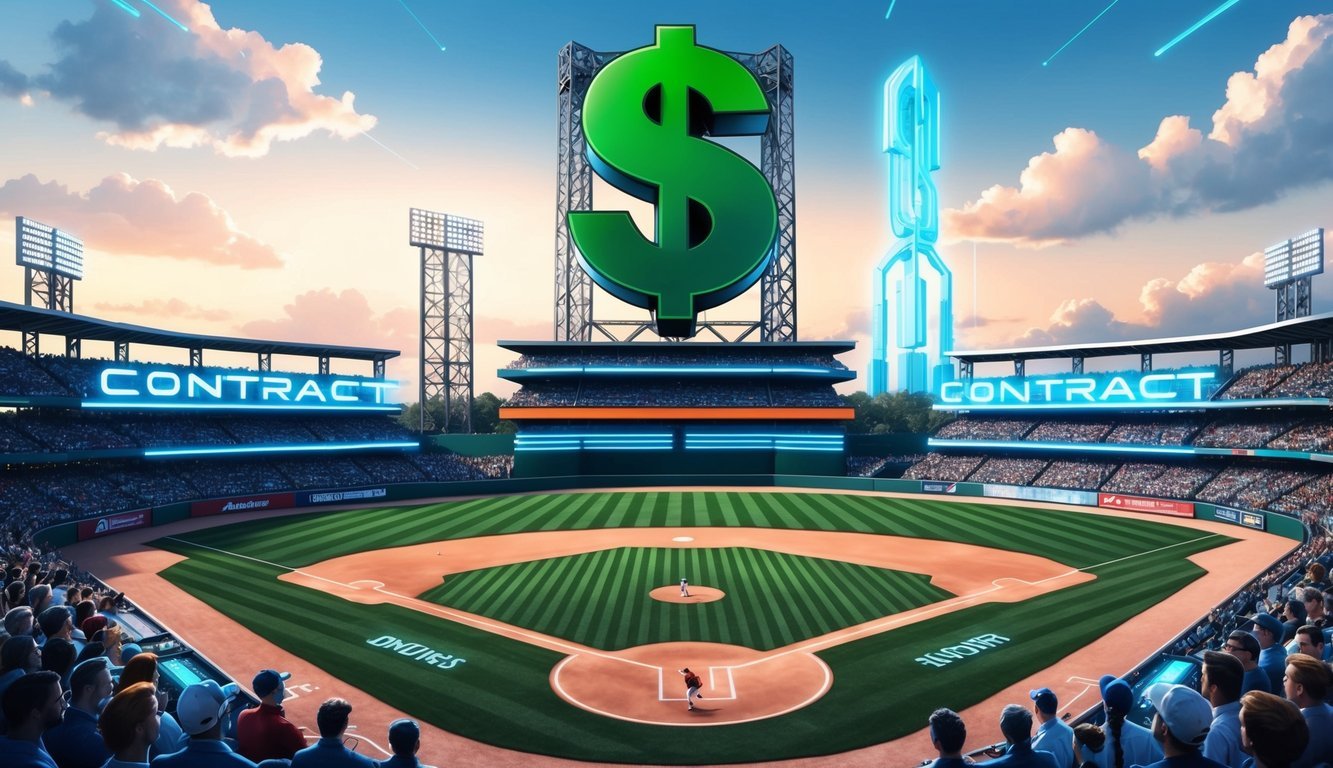Major League Baseball has seen some jaw-dropping contracts in recent years, with players signing deals worth hundreds of millions of dollars.
These mega-contracts reflect the immense value top-tier talent brings to MLB franchises and the competitive nature of the free agent market.
As of 2024, Shohei Ohtani holds the highest MLB contract.
He signed a 10-year, $700 million deal with the Los Angeles Dodgers in December 2023. This record-breaking agreement surpassed previous benchmarks set by stars like Mike Trout and Mookie Betts.
Ohtani’s unique two-way abilities as both a pitcher and hitter made him an unprecedented free agent, leading to his astronomical payday.
MLB’s biggest contracts often span a decade or more, with teams betting on sustained excellence from their marquee players.
While these long-term deals carry inherent risks, they allow franchises to lock up generational talents and build their rosters around cornerstone superstars.
As baseball revenues continue to grow, it’s likely we’ll see even more eye-popping contracts in the years to come.
Understanding MLB Contracts

MLB contracts are complex agreements that define a player’s compensation and commitment to a team.
These deals often involve substantial sums of money and can span many years, shaping both player careers and team strategies.
Contract Basics
MLB contracts specify the duration and financial terms of a player’s employment with a team.
The total value represents the maximum amount a player can earn over the contract’s life.
Years typically range from short-term deals of 1-3 seasons to long-term commitments of up to 10-15 years for star players.
Free agents can negotiate with any team, often leading to larger contracts.
Some deals include opt-out clauses, allowing players to become free agents before the contract ends.
Deferrals are another common feature, spreading payments over an extended period to manage a team’s budget.
Key Terminologies
Average Annual Value (AAV) is a crucial metric in MLB contracts.
Teams use AAV for luxury tax calculations and roster planning.
Guaranteed money refers to the portion of the contract a player will receive regardless of performance or injuries.
This can differ from the total value if incentives or option years are included.
Signing bonuses are upfront payments made when a player signs the contract.
These can be substantial, like Mookie Betts’ record $65 million bonus with the Dodgers.
Teams often use signing bonuses to attract free agents or structure contracts favorably for tax purposes.
Historical Contract Milestones
Baseball salaries have skyrocketed over the decades.
From modest beginnings to eye-popping figures, player contracts have shattered records time and again, reflecting the sport’s growing popularity and revenues.
Early Record-Breaking Contracts
In 1874, Ross Barnes earned $2,000, the highest salary in baseball at the time.
Fast forward to 1974, and Catfish Hunter signed a groundbreaking 5-year, $3.75 million deal with the Yankees.
This tripled the salary of any other player in the league.
The 1990s saw another leap.
Bobby Bonilla inked a $29 million contract with the Mets in 1991, surpassing Darryl Strawberry’s previous record by 60%.
This era set the stage for the massive contracts to come.
The 21st Century Boom
Alex Rodriguez broke new ground in 2000 with a $252 million deal.
He later topped his own record, signing a $275 million contract with the Yankees in 2007.
Miguel Cabrera and Derek Jeter also secured hefty deals.
Cabrera’s $292 million extension with the Tigers in 2014 was a high-water mark for its time.
More recently, Mookie Betts signed a 12-year, $365 million extension with the Dodgers in 2020, including a record $65 million signing bonus.
These contracts dwarf Babe Ruth’s peak salary of $80,000 in the 1930s, showcasing baseball’s financial evolution.
Top MLB Contracts
Baseball’s biggest stars command enormous salaries, with contracts reaching unprecedented heights in recent years.
Elite players are signing deals worth hundreds of millions, transforming the financial landscape of America’s pastime.
The Billion-Dollar Benchmarks
Shohei Ohtani set a new standard in 2023, inking a staggering $700 million deal with the Los Angeles Dodgers.
This 10-year contract dwarfs previous records, though much of it is deferred.
Mike Trout’s $426.5 million extension with the Angels held the previous record.
Mookie Betts secured $365 million from the Dodgers in 2020.
Not far behind is Fernando Tatis Jr., who signed a $340 million deal with the Padres in 2021.
These mega-contracts reflect the premium placed on generational talent in MLB.
All-Star Earners
Bryce Harper’s $330 million deal with the Phillies made waves in 2019.
Giancarlo Stanton’s $325 million contract with Miami (now with the Yankees) remains one of the largest ever signed.
Other top earners include Gerrit Cole ($324 million, Yankees) and Manny Machado ($300 million, Padres).
These deals often include opt-outs, no-trade clauses, and performance bonuses.
Annual salaries for these stars can exceed $35 million, making them among the highest-paid athletes in any sport.
Contract Impacts and Player Performance

Massive MLB contracts often come with sky-high expectations.
Players who sign these deals face intense pressure to deliver exceptional results on the field.
MVP-Level Contributions
Top-paid stars are expected to be perennial All-Stars and MVP candidates.
Mike Trout, who signed a 12-year, $426.5 million deal with the Angels in 2019, has lived up to the hype.
He’s finished in the top 5 of MVP voting in every full season he’s played.
Mookie Betts, on a 12-year, $365 million contract with the Dodgers, has maintained his elite status.
He’s earned All-Star selections and finished high in MVP voting multiple times since signing his mega-deal.
These players consistently post impressive stats.
High OPS for hitters and low ERA for pitchers are common benchmarks for success.
Their performances often place them among the game’s elite, drawing comparisons to legends of the past. Hank Aaron’s legacy in baseball serves as a reminder that sustained excellence over a career is just as important as single-season dominance.
Whether at the plate or on the mound, these athletes strive to etch their names alongside the all-time greats.
Expectations Vs. Reality
Not all big contracts yield the desired results.
Some players struggle under the weight of their massive deals.
Albert Pujols’ 10-year, $240 million contract with the Angels is often cited as cautionary tale.
Injuries can derail even the most promising careers.
Giancarlo Stanton, signed to a 13-year, $325 million deal, has battled various health issues that have limited his playing time.
Teams hope their big investments will lead to World Series glory.
The Dodgers’ acquisition of Mookie Betts paid off with a championship in 2020, where he earned World Series MVP honors.
Future Contract Trends

Baseball’s financial landscape continues to evolve rapidly.
Mega-deals for superstars and long-term contracts for young talent are reshaping the market.
Emerging Stars and Mega-Deals
Shohei Ohtani’s groundbreaking $700 million contract with the Dodgers has set a new benchmark for elite players.
This deal could pave the way for other two-way players to command similar salaries in the future.
Rising stars like Julio Rodriguez and Wander Franco have already secured long-term extensions early in their careers.
This trend is likely to continue as teams aim to lock up young talent before they hit free agency.
Corbin Carroll’s emergence with the Diamondbacks showcases the potential for lesser-known prospects to quickly become franchise cornerstones.
His success could inspire teams to offer substantial deals to promising rookies earlier than ever before.
Market Predictions and Player Value
As revenue streams grow, MLB payrolls are expected to increase.
This growth could lead to more $300+ million contracts for top-tier free agents in the coming years.
Position players like Aaron Judge and Rafael Devers have shown that offensive production remains highly valued.
Their recent deals suggest that power hitters will continue to earn premium salaries.
Analytics will play an even larger role in determining player value.
Teams may offer more incentive-laden contracts based on advanced metrics and performance indicators.
International talent could see a surge in high-value contracts as the global talent pool expands.
This might lead to bidding wars for top foreign prospects and established international stars.
